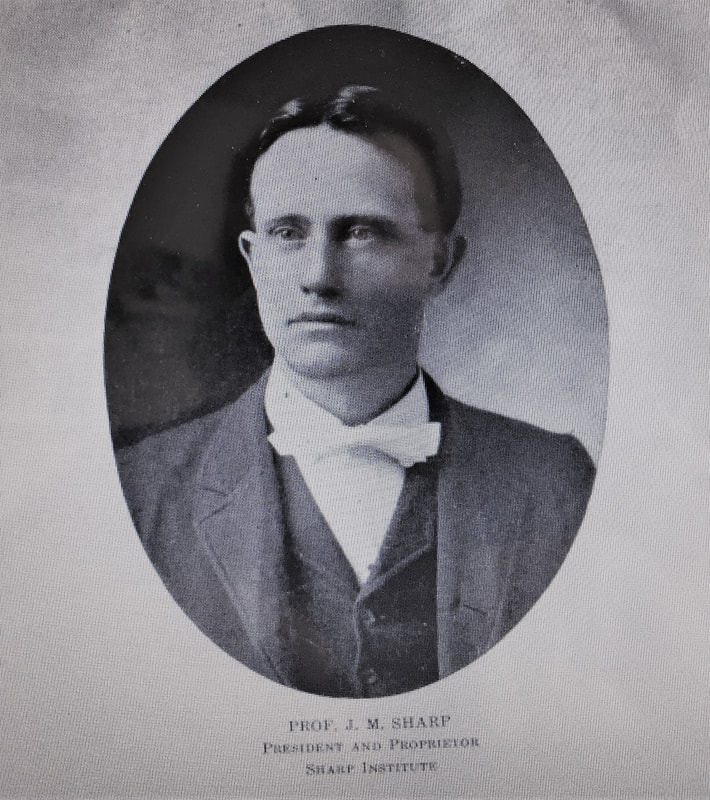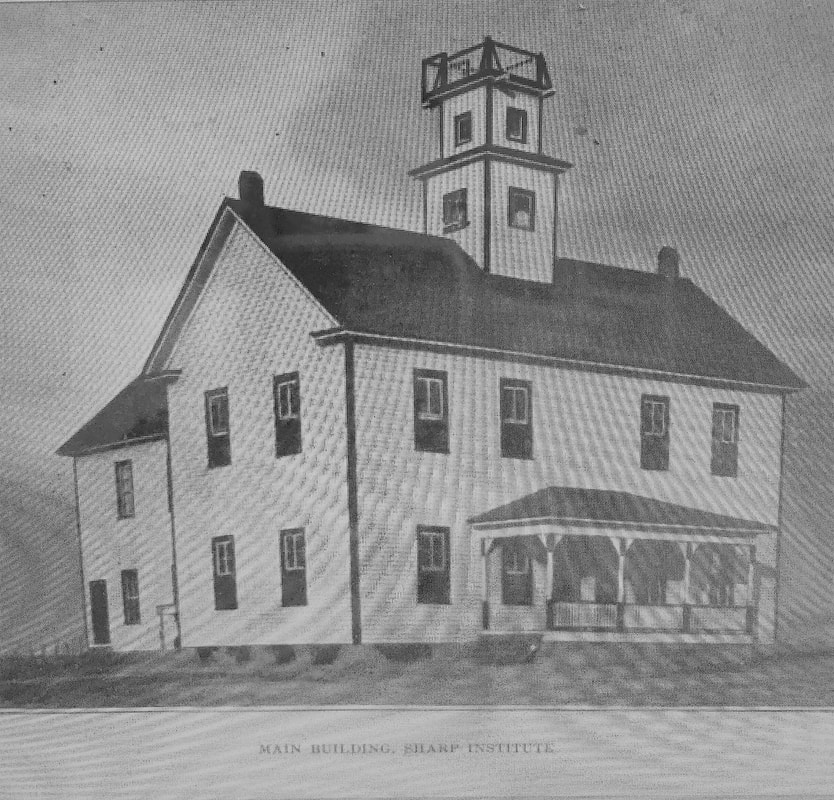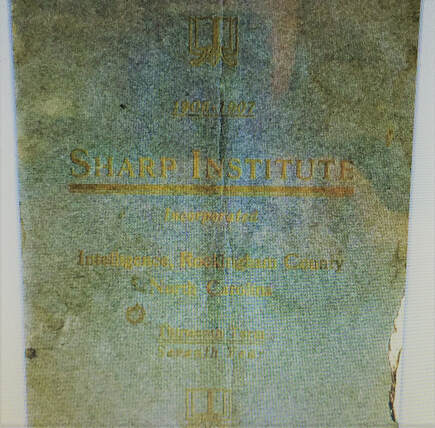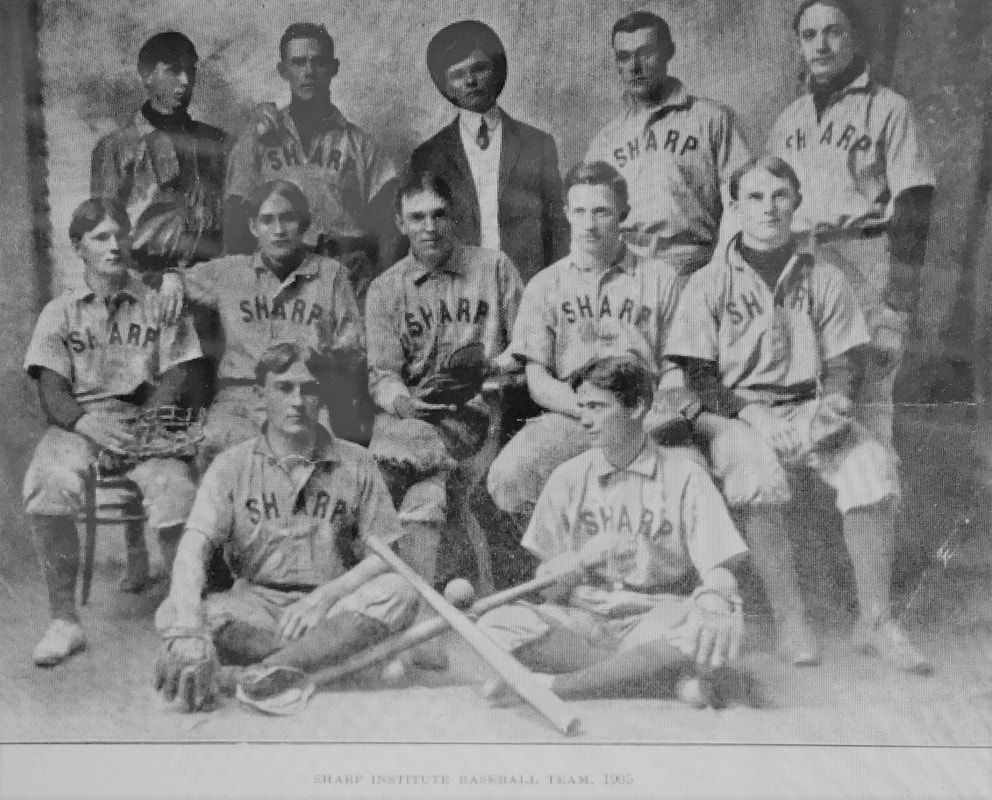|
In April 1904, the main building of the Sharp Institute was destroyed by a fire. The academy, a “nonsectarian and co-educational” day and boarding school in the Intelligence community, had been founded in 1900 by “President and Proprietor” James Merritt Sharp, the father of future North Carolina Supreme Court Chief Justice, Susie Sharp. In October of that year, the school opened with fifty students, and by the spring of 1902, enrollment had tripled to 166. In subsequent terms, more than two hundred pupils were instructed at Sharp Institute, about the same number of girls as boys. After the fire in the spring of 1904, students were taught in “small rooms of the neighborhood,” and commencement exercises were held at “the church in Intelligence” on May 4, with elocution and oratory contests and an address by the State Superintendent of Public Instruction, J. Y. Joyner. The school was rebuilt and ready for opening in the fall. In setting up his school and obtaining a mailing address for the site outside of the town of Madison, Sharp was directed by the Post Office to choose a name for the area that was not duplicated anywhere else in the state. Sharp chose “Intelligence” for the community surrounding the Institute. The school was advertised as being located in “a section of the Piedmont region unequaled for health and beauty” with some revered history, along one of the roads traveled by General Nathaniel Greene and his troops during the Revolution. Parents were promised close supervision of their children if they enrolled at Sharp Institute and that “no seductive influences” would be “thrown around the students to divert their attention.” Sharp also assured families that he would meet their children in Madison at the nearest railway stop and that they could reach him to notify him of their arrival because “the school is connected with Madison by phone.” The trip by wagon to the school, however, though only a matter of four and a half miles, would take forty minutes. One of the areas of instruction at the Sharp Institute was the “Normal Department.” Suggesting the widespread need for teachers in North Carolina at this time, these teachers in training were “often called on to take charge of schools before completing [the]...entire course.” Students could also receive instruction in business and music, as well as prepare for the university; tuition varied by course from $1.50 to $4.00 a month. The promotional brochure for the Institute boasted, “Probably no school in the State gives better facilities for musical training at so reasonable cost.” Students could study vocal music, plus piano, violin, mandolin, and guitar. Sharp promoted the Institute in its literature with a bold claim: “To say you have completed the courses prescribed by this institution means a recommendation that the world will recognize.” The school did, indeed, receive public attention and acclaim. Its baseball team played and won games against other “colleges and high-schools” in the state and was often written about in local newspapers. In 1903, a crowd of about two thousand attended the Sharp Institute end-of-the-year ceremonies, hearing a speech from Governor Charles Aycock at the closing exercises. In the Institute’s 1906 brochure, Congressman W. W. Kitchin praised Sharp as an “earnest, industrious, energetic, and progressive educator.” And, in testimony to the “excellent school” that Sharp had established, Aycock and several local officials recommended that North Carolina citizens contribute financially to the educational endeavors in Intelligence. Despite thriving and growing in numbers and academic reputation, however, the Institute lasted only about seven years, its tenure marred by a second devastating fire in January 1907. After the second fire, Sharp did not rebuild. He later moved to Reidsville where he established a law practice. Along with fledgling public schools, other early twentieth century private academies, including the Reidsville Seminary and the Leaksville-Spray Institute, continued to educate the youth of Rockingham County. References:
“Sharp Institute,” Brochure for 1906-1907 Term, Intelligence, North Carolina, MARC Collections, 3, 4, 5, 6, 7, 8, 9-10, 11, 12, 13, 14, 17, 21, 22-23, 25-30; Reidsville (NC) Review articles: “Madison vs. Sharp,” April 1, 1904, 2; “Localettes,” April 8, 1904, 3; April 12, 1904, 3; April 19, 1904, 3; April 22, 1904, 3; May 6, 1904, 3; January 25, 1907, 4; and January 29, 1907, 3; Anna R. Hayes, Without Precedent: The Life of Susie Marshall Sharp (Chapel Hill: University of North Carolina Press, 2008), 7-8, 11, 12-14; “Sharp Institute, 8; Catawba College, 4,” Greensboro (NC) Daily News, April 27, 1906, 6. Of the 189 students enrolled in 1905-1906, the numbers skewed toward males with 110 boys listed in the 1906-1907 brochure. Most were from Rockingham County, but students also hailed from nine other North Carolina counties and Virginia.
1 Comment
Marsha Fulp
8/6/2023 10:27:45 pm
I am so happy to find this site. My grandfather, Cabell Crawford Fulp (1888-1967) attended the Sharp Institute. I am not sure of year or years attended, if you have any more information regarding years he attending or any information I would gladly appreciate it,
Reply
Leave a Reply. |
Articles
All
AuthorsMr. History Author: Bob Carter, County Historian |
|
Rockingham County Historical Society Museum & Archives
1086 NC Hwy 65, Reidsville, NC 27320 P.O. Box 84, Wentworth, NC 27375 [email protected] 336-634-4949 |




 RSS Feed
RSS Feed
